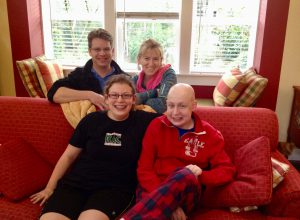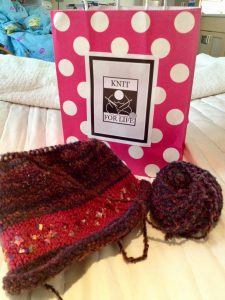
The proverb that suggests it takes a village to raise a child can be easily adapted for parents facing the various challenges that come with having a child with special needs and circumstances. Parents sometimes need the support of a village. Author Kristin Jarvis Adams shared her experiences with On the Pulse in finding her village when her son, Andrew, was diagnosed with autism and years later, when he was treated and overcame a rare immune disorder at Seattle Children’s and Seattle Cancer Care Alliance. Adams, who is a member of the Autism Center Guild at Seattle Children’s, tells her family’s story in her book The Chicken Who Saved Us: The Remarkable Story of Andrew and Frightful.
For 10 years my husband and I had been making trips to and from Seattle Children’s with our autistic son, Andrew, who suffered from an unheard of progressive inflammatory disease. Andrew had been in the hospital for months, his body riddled with gaping ulcers, his organs compromised by chronic inflammation. Now we were in the middle of chemotherapy and radiation treatments that were preparing him for an experimental bone marrow transplant. It was our last hope.
Despite friends and family living within driving distance of the hospital, no one understood what it was like to be there 24 hours a day, sitting with a child who was in constant pain. I felt desperately alone—a feeling that was all too familiar.
When Andrew entered grade school with the diagnosis of autism metaphorically stamped on his back, dreams of birthday parties, soccer teams and being the cool house on the block vanished.
Instead, I was shuttling my son to countless medical appointments and therapies in hopes of making his world a little easier to bear. On the days it became too much, I cancelled everything and stayed home where Andrew felt safe in a quiet and predictable environment.
A gnawing feeling of isolation overwhelmed me until I began volunteering at the school. Once there, I met a tribe of special needs parents who provided respite, humor and an abundance of resources to help me navigate my way.
Sewing, seeds of support
But back in the hospital on an uncharted road, I felt alone again. Andrew’s autism made it difficult for him to communicate with his medical team, so it forced us to be creative. At his sister’s suggestion, we brought an iPad into his hospital room so he could talk to his beloved pet chicken Frightful over a FaceTime connection.
Frightful became his confidant, the one being with whom he would share his fears. But one day I heard Andrew tell her his body was trying to kill him and I was left with the terrifying job of translating his meaning to his medical team. The weight of responsibility pressed heavy on my chest and I knew the burden of care had become too difficult to manage on my own.
After several attempts, Andrew’s nurse managed to coax me into a nearby playroom in the hospital where a group of women were knitting. It was clear most had spent countless nights at the hospital. Despite their clear need for a week of uninterrupted sleep, these women possessed an inner glow that stemmed from the pure joy of sitting next to another person who understood exactly how they felt. Relief oozed from their pores and onto their faces, making them radiate with beauty.
They were my people.

My people
Knit for Life came to the unit every other week to spend time with the moms in one of the open playrooms. Knitting with others provided escape from the isolation of illness and the constant fear we carried in our hearts. Two volunteers arrived that afternoon with bins of yarn, needles and an abundance of patience for teaching an assorted group of bone-weary women to knit.
“Do you know how to knit?” the instructor asked when she spied me lingering in the doorway.
“I’m not sure. When I was in grade school, my neighbor spent a summer teaching me. It’s been so long, I’m sure I don’t remember.”
“Find some yarn you like and I’ll give you a lesson,” she said with a genuine smile. Bins of colorful yarn were offered to me and I caressed each skein like a lifeline.
Handing me a set of circular needles, she carefully taught me how to cast-on stitches to begin, and showed me the difference between a knit and a purl stitch. My grade school lessons came flooding back as I remembered the gentle grip of my neighbor holding my awkward 8-year-old hands tightly in hers. A deep sigh escaped from my heart as I concentrated on my needles with the same expression of delight as my new companions.
It was like God had noticed my brokenness and pushed me into this room so I could breathe again. My sorrow and loneliness had a place to live out loud and I didn’t need to speak to know I was understood.
While I twisted yarn into something useful, I listened to the women’s voices, woven together in a disorganized song of relief. Once again, I had found a village inhabited with people who could say, “We know what you’re going through. You’re not alone.”
Hats and hope
A week after the transplant, Andrew’s immune system was wiped out and his organs were being closely monitored. He received his first blood transfusion to treat the anemia brought on by total body radiation.
The only thing my husband and I could do was wait. To diffuse my growing anxiety, I was knitting hats as fast as I could get my hands on new yarn. They were a mishmash of colors and textures, the stitches reflecting my moods—sometimes tight and precise, more often uneven, with dropped stitches here and there.
Each day I joined my small village of women in the playroom while we knitted a silent prayer for our children who were fighting to stay alive behind closed doors. We found joy in watching as something new emerged from our rows of knots. We spoke kindness in needle-clicks, and love in the offering of hands as another wound their skein of yarn around our palms.
As I finished each hat, I thanked it for keeping me occupied, understanding that knitting had become my healing, my way of being still when all I wanted to do was grab my child into my arms. It was a time when the only thing that made sense was the next purl stitch, and then the next and the next.
“What are you making, Mom?” Andrew asked me one afternoon.
“Just some hats,” I replied.
“I have Frightful,” he said, holding up his iPad with a picture of his beloved chicken. “She helps me. I tell her all the scary things that won’t get out of my head.”
I recognized the wisdom in his words as I fiddled with my nearly finished hat. I thought of all the scary things in my head, and the life-giving conversations I had with my village of knitters—mothers and grandmothers, aunts and sisters—all who were waiting and hoping and praying for their loved ones to heal.
“My hats help me, too. Just like your chicken,” I told Andrew. “I talk to them with my needles, and they talk back.”
The needles and yarn gave me a task that made something useful out of my worried thoughts. The women I knit with gave me a place of understanding during a time I desperately needed community. Although our lives were as different as our knitting, we each had the same desire to belong.
Together we forged friendships in the many colors and textures of yarn as it slipped through our fingers and became its own unique shape. When I showed Andrew my first completed hat, he gave me no words, but the upturned lips he offered in reply was his first smile in months.
That felt like hope.
Today, after undergoing an allogenic bone marrow transplant at Seattle Children’s in February 2012 at the age of 18, Andrew is healthy, and with the assistance of a job coach, he is realizing his dream of working as a prep chef in a local catering kitchen. He still talks to his chickens every day. As for me, I will always find solace in the needles and yarn that were the doorway to my lifeline – my village.

